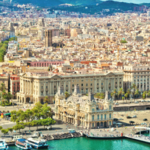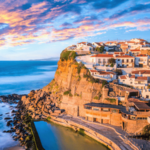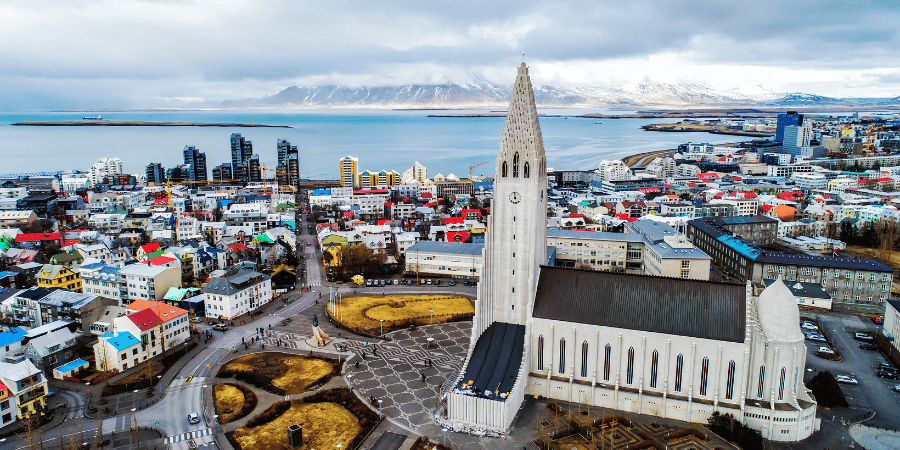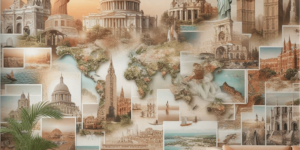Quick Links:
Travel Guides | Travel Gear | Packing Lists | Resources & Tools
Reykjavik serves as the perfect gateway to Iceland’s otherworldly landscapes and natural phenomena. The city itself offers a vibrant arts scene, unique architecture, and excellent cuisine. From here, visitors can explore geothermal hot springs, witness the Northern Lights, and venture into dramatic landscapes of volcanoes, glaciers, and black sand beaches. Reykjavik is ideal for those seeking a blend of urban culture and pristine nature.
Best Things to Do
Search and Compare flight deals
Deals from your favorite airlines.
Best Hotels in Reykjavik
Why to Go:
- Gateway to Natural Wonders: Reykjavik is the perfect starting point for exploring Iceland’s breathtaking natural attractions. From here, visitors can easily access the famous Golden Circle route, which includes the stunning Gullfoss waterfall, the geothermal area of Geysir, and Thingvellir National Park.
- Northern Lights: Reykjavik is one of the best places in the world to witness the mesmerizing Aurora Borealis. During the winter months, visitors have a good chance of seeing this spectacular natural light show, with many tour operators offering Northern Lights excursions.
- Geothermal Pools: The city is famous for its geothermal pools and spas. The Blue Lagoon, located just outside Reykjavik, is a world-renowned geothermal spa known for its mineral-rich waters and stunning surroundings. Within the city, public pools like Laugardalslaug offer a more local experience.
- Vibrant Arts and Culture: Reykjavik boasts a thriving arts scene, with numerous museums, galleries, and cultural events. The striking Harpa Concert Hall is a must-visit for its impressive architecture and regular performances. The city also hosts various festivals throughout the year, celebrating music, film, and literature.
- Unique Architecture: The city’s architecture is a blend of colorful traditional houses and modern designs. The Hallgrímskirkja Church, with its distinctive design inspired by basalt lava flows, offers panoramic views of the city from its tower.
- Culinary Experiences: Reykjavik’s food scene is diverse and innovative, offering everything from traditional Icelandic cuisine to international flavors. Visitors can try local specialties like fermented shark, Icelandic lamb, and fresh seafood. The city also has a growing reputation for its craft beer scene.
- Whale Watching: Reykjavik’s harbor is a departure point for whale watching tours, offering the chance to see various species of whales and dolphins in their natural habitat. The best time for whale watching is typically from April to October.
- Midnight Sun: During the summer months, Reykjavik experiences the phenomenon of the midnight sun, where the sun never fully sets. This creates unique lighting conditions and allows for extended sightseeing hours.
- Easy Exploration: Reykjavik is a compact and walkable city, making it easy to explore on foot. The city also has an efficient bus system for reaching attractions further afield. Renting a car is a popular option for those wanting to explore Iceland’s countryside.
- Eco-Friendly City: Reykjavik is known for its commitment to sustainability and eco-friendly practices. The city runs almost entirely on renewable energy, and there’s a strong emphasis on environmental conservation throughout Iceland.
On a similar note...
-

8 Airport Safety Tips: How to Keep Your Stuff Safe
-

7 TSA Secrets You Need to Know
-

The 10 Best Airport Tips and Secrets
-

Cappadocia, Turkey Travel Guide
-

Amalfi Coast, Italy Travel Guide
-

Barcelona, Spain Travel Guide
-

Sintra, Portugal Travel Guide
-

Marrakech, Morocco Travel Guide
-

World's Best Places to Visit near me
-

Palm Springs, USA Travel Guide
Reykjavik Travel Tips
Best Months to Visit
The best time to visit Reykjavik is during the summer months (June to August) when the weather is mild, the days are long, and many festivals take place. The shoulder seasons (May and September) offer fewer tourists and still relatively mild weather. Winter (October to April) is colder and darker but perfect for witnessing the Northern Lights and experiencing unique winter activities.
The Weather on Reykjavik
Reykjavik has a subpolar oceanic climate with cool summers and cold winters:
- Summer (June to August): Temperatures range from 9°C (48°F) to 15°C (59°F). The long daylight hours (nearly 24 hours of daylight in June) make it ideal for exploring.
- Autumn (September): Temperatures range from 5°C (41°F) to 10°C (50°F). It’s a quieter time with the first glimpses of fall colors.
- Winter (October to April): Cold and dark, with temperatures between -1°C (30°F) and 4°C (39°F). The long nights are perfect for seeing the Northern Lights.
- Spring (May): Temperatures range from 3°C (37°F) to 9°C (48°F). The days start to lengthen, and the weather gradually warms up.
How to Save Money on Reykjavik
Travel Off-Peak: Visit during the shoulder seasons (May and September) for lower accommodation prices and fewer crowds.
Public Transport: Use the city’s bus system, Strætó, for affordable transportation. Consider purchasing a day pass for unlimited travel.
Free Attractions: Many of Reykjavik’s top attractions, such as Hallgrímskirkja church, the Harpa concert hall, and various public parks, are free to explore.
Eat Locally: Enjoy meals at local bakeries, food trucks, and casual eateries rather than high-end restaurants. Try traditional Icelandic dishes for a more authentic and affordable experience.
Discount Cards: Consider purchasing the Reykjavik City Card, which offers free entry to many attractions, unlimited public transport, and discounts on tours and activities.
Download for FREE
Travel Budget Planner & Checklist in Excel
Start using the Ultimate Travel Budget Planner and Checklist in Excel today, and embark on your dream trip without the stress of overspending. Happy Travel!
Download!What to Eat
Reykjavik offers a unique culinary scene with a mix of traditional Icelandic cuisine and modern flavors:
Lamb: Icelandic lamb is known for its quality and flavor. Enjoy it roasted, stewed, or in soups.
Skyr: A traditional Icelandic dairy product similar to yogurt but thicker and creamier, often served with berries or honey.
Seafood: Fresh and delicious seafood dishes are common, including cod, haddock, and langoustine (Norway lobster).
Hot Dogs: Reykjavik’s hot dogs (pylsur) are famous, especially from the Bæjarins Beztu Pylsur stand. They’re typically served with fried onions, raw onions, ketchup, mustard, and remoulade.
Kleinur: Icelandic twisted doughnuts, often enjoyed with coffee.

The FREE Packing Guide for All-Inclusive Trips
Download our fillable and printable packing list + tips + more!
Safety
Reykjavik is one of the safest cities in the world, but it’s still important to take standard precautions:
Petty Theft: While rare, it’s always wise to keep an eye on your belongings, especially in crowded areas.
Weather: The weather in Reykjavik can change rapidly. Dress in layers and be prepared for sudden changes.
Traffic: Be careful when crossing streets and use pedestrian crossings. Traffic can be busy in the city center.
Health Precautions: Tap water is among the cleanest in the world. Ensure you have travel insurance that covers medical emergencies and unexpected situations.
Emergency Services: Familiarize yourself with emergency contact numbers. The general emergency number in Iceland is 112.
Getting Around
Public Transport: Reykjavik’s bus system, Strætó, is reliable and affordable. Purchase tickets via the app or from kiosks.
Walking: Many of Reykjavik’s attractions are within walking distance of each other. Walking is a great way to explore the city’s vibrant streets and waterfront.
Biking: Renting a bike is an eco-friendly and enjoyable way to explore Reykjavik. There are several bike rental shops and scenic cycling paths.
Taxis and Ride-Sharing: Taxis are available but can be expensive. Ride-sharing services are limited, so it’s often best to use public transport or walk.
Car Rentals: Renting a car is ideal for exploring areas outside of Reykjavik. Ensure you’re comfortable driving in varying weather conditions and familiar with local driving regulations.
Entry & Exit Requirements
Visa Requirements: Visitors from many countries, including the USA, Canada, EU countries, and Australia, do not need a visa for short stays (up to 90 days). Check the latest visa requirements based on your nationality.
Passport Validity: Ensure your passport is valid for at least three months beyond your planned departure date from Iceland.
Customs Regulations: Familiarize yourself with customs regulations regarding what you can bring into and take out of Iceland. Common restrictions include limits on alcohol, tobacco, and certain food items.
Health Requirements: No specific vaccinations are required for entry into Iceland, but it’s always a good idea to check for any travel health advisories and ensure you have travel insurance that covers medical emergencies.
Final Thoughts
Reykjavik, with its stunning natural beauty, rich cultural heritage, and vibrant city life, offers an unforgettable experience for every traveler. Whether you’re soaking in the Blue Lagoon, exploring the Golden Circle, or enjoying the city’s dynamic arts scene, Reykjavik promises a unique and enriching adventure. By planning your trip wisely and taking advantage of local tips, you can enjoy all that this captivating city has to offer while staying within your budget.
Recommended for You
In the heart of mainland Greece, where the Pindus Mountains...
Venturing into the great outdoors on a hiking adventure requires...
Author

Cotripia is your gateway to elevated travel. We serve as your portal to the world of stylish travel, exquisite beauty products, luggage, and all the vital travel essentials. Furthermore, we provide an array of valuable resources, including expertly crafted packing guides, meticulous checklists, insider tips, enlightening ebooks, and much more.
View all posts








